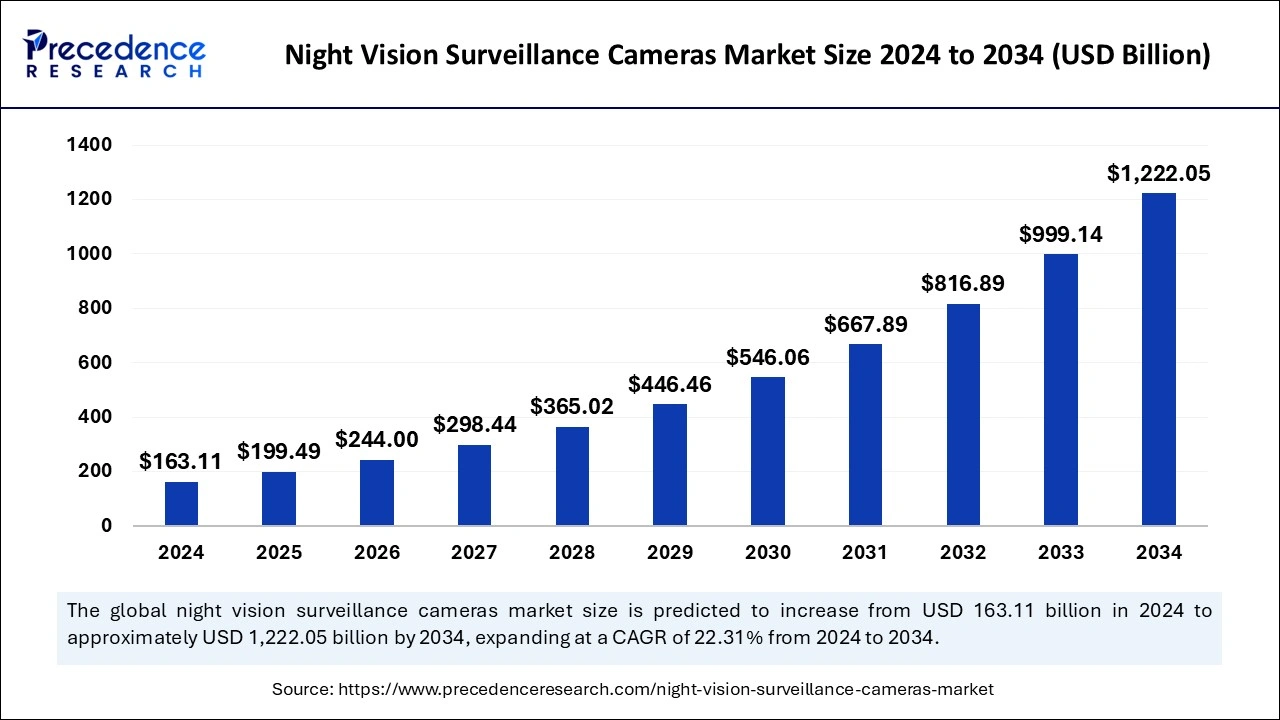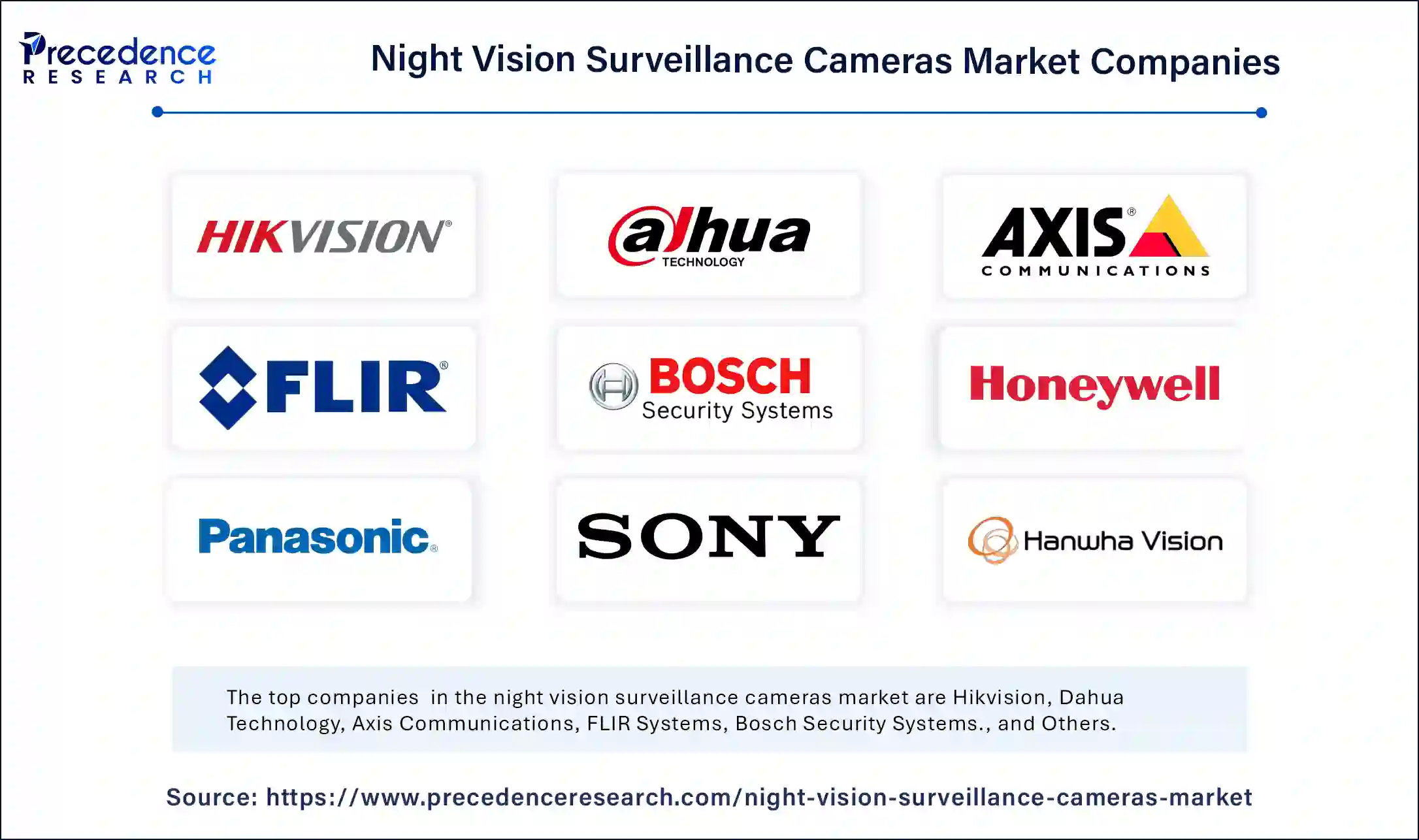The global night vision surveillance cameras market size is calculated at USD 199.49 billion in 2025 and is forecasted to reach around USD 1,222.05 billion by 2034, accelerating at a CAGR of 22.31% from 2025 to 2034.
The global night vision surveillance cameras market size accounted for USD 163.11 billion in 2024 and is expected to exceed around USD 1,222.05 billion by 2034, growing at a CAGR of 22.31% from 2025 to 2034. The growth of the global night vision surveillance cameras market is attributed to rising technological advancements and increasing security concerns.

The night vision surveillance camera is a technological help that has helped security and privacy. Artificial Intelligence helps to innovate and advance these surveillance cameras. It enhances night vision technologies, can detect temperature anomalies that could indicate chemical pills and files, and enables surveillance in no-light and low-light conditions. This proactive approach enables early detection of potential threats, including someone exhibiting unusual behavior and loitering in a sensitive area.
AI-generated advanced technologies will revolutionize the growth of the night vision surveillance cameras market in the near future. Advanced systems can identify and detect objects such as security risks. AI-generated surveillance cameras are capable of recognizing individuals through facial recognition technology. In addition, AI is used to catalog and read license plates, which is valuable in enforcing traffic and parking regulations, tracking stolen vehicles, and monitoring vehicle traffic.
The night vision surveillance cameras market deals with cameras that provide surveillance capabilities used in the protection of systems, assets, and people. The major factors driving the market growth are the increasing security concerns in the public sector and the increasing requirement for advanced surveillance technology. In addition, the major benefits include low power cost and ability, high resolution, best identification and recognition, enhanced visible imaging, and low-light-level sensitivity.
Increasing demand for night vision cameras in automotive vehicle applications is further driving the growth of the market. The integration of digital ecosystems such as analytics, AI, and the Internet of Things is pushing the boundaries and creating major opportunities. Various industries leveraging these integrations can improve performance, boost productivity, and monitor usage in real-time.
| Report Coverage | Details |
| Market Size by 2024 | USD 163.11 Billion |
| Market Size in 2025 | USD 199.49 Billion |
| Market Size in 2034 | USD 1,222.05 Billion |
| Market Growth Rate from 2025 to 2034 | CAGR of 22.31% |
| Dominating Region | North America |
| Fastest Growing Region | Asia Pacific |
| Base Year | 2024 |
| Forecast Period | 2025 to 2034 |
| Segments Covered | Product Type, Type, End Use Application, and Regions. |
| Regions Covered | North America, Europe, Asia-Pacific, Latin America, and Middle East & Africa. |
The increase in terrorist activities
The increase in security and safety concerns, political tensions over border issues, and the increase in terrorist activities have resulted in increased demand for night vision cameras in the defense and military industries. The defense and military sectors are embracing night vision surveillance cameras to address the increasing demand for combat operations and night patrolling. Major countries' increasing government investments in night vision cameras are driving the market growth. In addition, the smart home security camera with night vision can track, analyze, recognize, and detect objects, cars, and people.
High cost of night surveillance cameras
The high cost of night surveillance cameras is the major challenge restraining the market growth. The night surveillance camera can't afford everyone and is not cost-friendly. The usage of expensive third-generation technologies and unique materials increases the price of night vision surveillance cameras. In addition, less awareness about the advantages of night vision surveillance cameras and insufficient data storage capacity are also major obstacles that are further expected to restrain the growth of the night vision surveillance cameras market.
The rising technological advancements
The rising technological advancement in the market is the major opportunity driving the market growth. The increasing innovations in connectivity, image processing, and sensor technology rendered these cameras more affordable, effective, and easier to integrate into existing security frameworks. In addition, governments are pushing organizations to invest in surveillance systems such as night vision capabilities and implementing strict regulations regarding public safety. Furthermore, the integration of advanced surveillance systems in smart cities further increases the demand for cameras. In addition, the an increasing prevalence of remote monitoring systems in several industries.
The dome camera segment led the night vision surveillance cameras market in 2024. The Dome cameras segment plays an important role in market growth. These cameras are known for their discreet surveillance capabilities. These cameras are often used in indoor environments such as public buildings, offices, and retail stores. As the camera’s direction is not easily discernible, the dome-shaped design deters vandalism and provides a wide range of views. In addition, the growth of the dome camera segment is attributed to the increasing emphasis on aesthetic integration in modern infrastructure combined with robust security measures to enhance the integration of dome cameras.
The bullet camera segment will grow at a significant rate during the forecast period. The Bullet cameras are known for their rugged design and long-range viewing capabilities. Bullet cameras are widely used in outdoor surveillance. These cameras are made to avoid extreme weather situations and make them suitable for industrial sites, parking lots, and perimeter security. In addition, the segment growth is attributed to the increasing need for high-performance and durable outdoor surveillance solutions. Furthermore, the rising advancements in IR technology improve their night vision capabilities.
The PTZ segment dominated the global night vision surveillance cameras market. The PTZ (Pan-Tilt-Zoom) cameras are gaining traction for their advanced features and versatility. These cameras enable remote control over the zoom and viewing angle and make them ideal for dynamic monitoring scenarios and larger areas. PTZ cameras are widely used in industrial and commercial settings where real-time tracking and comprehensive coverage of activities are necessary. The ability of PTZ cameras to cover huge areas with a single device reduces the need for multiple cameras and enhances security management.
The public sector and defense segment dominated the night vision surveillance cameras market in 2024. One of the largest consumers of night vision surveillance cameras is the public and defense sector. These cameras are tailored for various applications such as military operations, public safety, and border security. The segment growth is attributed to the increasing need for tamper-proof, reliable, and high-performance surveillance solutions in national security. Furthermore, the increasing government initiatives to enhance infrastructure security and public safety.
The industrial segment is expected to grow fastest during the forecast period. Surveillance cameras are necessary for monitoring production lines, warehouses, and large facilities in the industrial sector. The ability to capture clear images in low-light conditions reduces the risk of unauthorized activities and risk of accidents and ensures continuous oversight of operations. In addition, the robust and ideal design of industrial-based cameras, combined with advanced features such as motion detection and thermal imaging, makes them ideal for critical infrastructure and harsh environments.
Rapid Adoption of Surveillance Systems in the North American Market
North America dominated the night vision surveillance cameras market in 2024. The market growth in the region is attributed to the increasing high adoption rates of advanced security technologies. In addition, the increasing demand for sophisticated security solutions in both commercial and residential sectors and the presence of major surveillance camera manufacturers are further expected to drive the surveillance camera industry.
The U.S. and Canada are the major countries in terms of market growth. The U.S. is the major contributor to the implementation of surveillance systems in private properties, critical infrastructure, and public spaces. Moreover, due to the regulatory mandates and technological advancements for enhanced security measures, the market in the region is expected to experience steady growth.
Asia Pacific Market Driven by Developing Infrastructure
Asia Pacific is expected to grow at the fastest rate in the night vision surveillance cameras market during the forecast period. The market growth in the region is attributed to the rising significant investments in infrastructure development, increasing security concerns, and increasing rapid urbanization. China, India, Japan, and South Korea are the major countries that use advanced surveillance systems to enhance public security and safety. The increasing government initiatives and the growing number of smart city projects to enhance surveillance infrastructure are the major factors contributing to the industry.

By Product Type
By Type
By End User Application
By Geography
For inquiries regarding discounts, bulk purchases, or customization requests, please contact us at sales@precedenceresearch.com
No cookie-cutter, only authentic analysis – take the 1st step to become a Precedence Research client